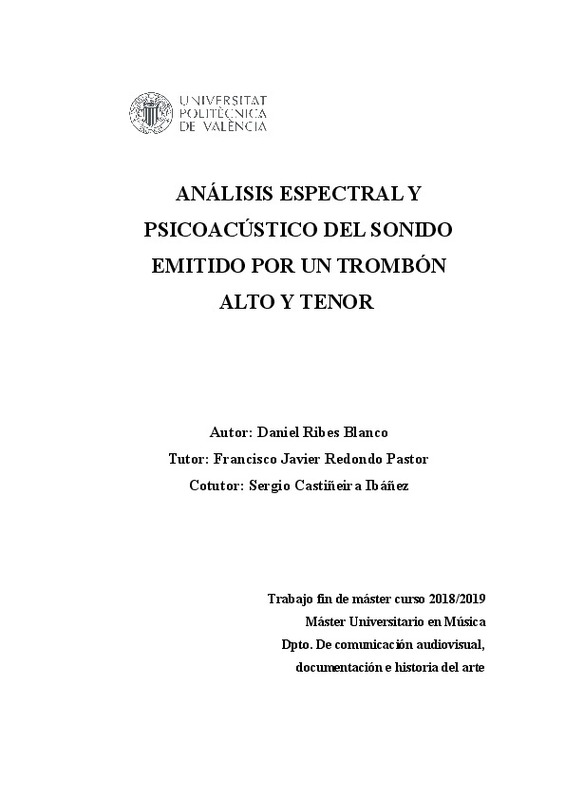JavaScript is disabled for your browser. Some features of this site may not work without it.
Buscar en RiuNet
Listar
Mi cuenta
Estadísticas
Ayuda RiuNet
Admin. UPV
Análisis espectral y psicoacústico del sonido emitido por un trombón alto y tenor
Mostrar el registro sencillo del ítem
Ficheros en el ítem
| dc.contributor.advisor | Redondo Pastor, Francisco Javier
|
es_ES |
| dc.contributor.advisor | Castiñeira Ibáñez, Sergio
|
es_ES |
| dc.contributor.author | Ribes Blanco, Daniel
|
es_ES |
| dc.date.accessioned | 2019-10-29T12:44:07Z | |
| dc.date.available | 2019-10-29T12:44:07Z | |
| dc.date.created | 2019-07-18 | |
| dc.date.issued | 2019-10-29 | es_ES |
| dc.identifier.uri | http://hdl.handle.net/10251/129936 | |
| dc.description.abstract | [ES] En este trabajo se cuestiona sobre la necesidad de uno de los instrumentos afines al trombón tenor, el trombón alto, que junto al bajo y el tenor, ha sido una formación la cual ha existido desde las primeras orquestas sinfónicas modernas conocidas a día de hoy desde el S.XIX. Esta formación diferenciaba bien a los tres trombones por su papel fundamental en la orquesta, principalmente como relleno armónico, siendo el trombón bajo el más grave, el tenor el central y el alto el más agudo. El tamaño del instrumento, como es bien sabido, afecta a la tesitura y como no, al sonido que produce el mismo: a mayor tamaño, más grave suena éste. Así, en la familia de los trombones el más grande, trombón bajo, es el que suena más grave, mientras que el de menor tamaño, trombón alto, produce sonidos más agudos, estando en el medio el trombón tenor. Con el paso de los años la posición en el plano orquestal del trombón alto, tenor y bajo se ha ido repartiendo entre los atriles: primero, segundo y tercero, respectivamente, buscando más homogeneidad y compactación sonora entre ellos, llegando hasta el límite de prescindir del trombón alto en la segunda mitad del S.XIX. Dada la evolución que ha sufrido la familia del trombón con el paso del tiempo, incluso llegando a la sustitución del trombón alto por el tenor en muchas orquestas sinfónicas, en este trabajo se buscan las posibles causas. Para ello, se analizan las diferencias fundamentales desde un punto de vista físico y psicoacústico de ambos. Se realiza un análisis de muestras obtenidas mediante una cata a ciegas, comparando fragmentos originales de trombón alto y tenor que han sido interpretados tanto por un tenor como un alto de forma aleatoria y en situaciones diferentes. El objetivo de este trabajo es concluir si el trombón alto puede sobrevivir a las tendencias musicales del S.XXI, y en tal caso, si es necesario o no, recuperar dicho instrumento en las orquestas sinfónicas clásicas. | es_ES |
| dc.description.abstract | [EN] In this study, the need for one of the instruments related to the tenor trombone, the alto trombone, which along with the bass and the tenor have been a formation which has existed since the first modern symphony orchestras known to date from the S.XIX. This formation differentiated well to the three trombones for its fundamental role in the orchestra, mainly as harmonic filler, being the trombone bass the most low, the tenor the central and the highest the most acute. The size of these instruments is of greater to smaller size, affecting the sound and the tessitura of the instrument. But over the years the role of alto trombone, tenor and bass have been replaced by first, second and third, seeking more homogeneity between the roles and trying to find a more compact sound between them, reaching the limit of dispensing with the alto trombone in the second half of the nineteenth century. This research analyzes the sound spectrum of the alto and tenor trombone, its differences and similarities and a blind sample experiment comparing original fragments of alto and tenor trombone interpreted both by a tenor and a alto in a random way and in different situations, to carry out a survey on whether they can be differentiated or not, and to reach the conclusion of whether the alto trombone can survive the musical tendencies of the 21st century, and if it is necessary to recover this instrument in the classical symphonic orchestras. | es_ES |
| dc.language | Español | es_ES |
| dc.publisher | Universitat Politècnica de València | es_ES |
| dc.rights | Reserva de todos los derechos | es_ES |
| dc.subject | Trombón tenor alto | es_ES |
| dc.subject | Espectro sonoro | es_ES |
| dc.subject | Psicoacústica | es_ES |
| dc.subject.classification | FISICA APLICADA | es_ES |
| dc.subject.other | Máster Universitario en Música-Màster Universitari en Música | es_ES |
| dc.title | Análisis espectral y psicoacústico del sonido emitido por un trombón alto y tenor | es_ES |
| dc.type | Tesis de máster | es_ES |
| dc.rights.accessRights | Abierto | es_ES |
| dc.contributor.affiliation | Universitat Politècnica de València. Departamento de Física Aplicada - Departament de Física Aplicada | es_ES |
| dc.description.bibliographicCitation | Ribes Blanco, D. (2019). Análisis espectral y psicoacústico del sonido emitido por un trombón alto y tenor. http://hdl.handle.net/10251/129936 | es_ES |
| dc.description.accrualMethod | TFGM | es_ES |
| dc.relation.pasarela | TFGM\90604 | es_ES |






